Insecticides
The world market for insecticides is dominated by compounds interfering with the nervous system of pest invertebrates, since this target organ usually provides rapid control. Insecticides acting on target sites such as acetylcholinesterase (organophosphates and methyl carbamates), voltage-gated sodium channels (pyrethroids), nicotinic acetylcholine receptors (neonicotinoids) and ligand-gated chloride channels (macrocyclic lactones and phenylpyrazoles) account for more than 75% of total insecticides sales (Figure 5).
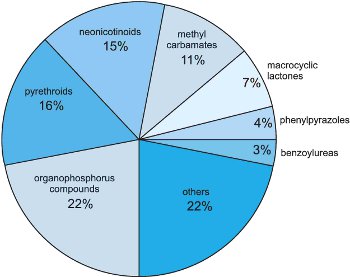
Figure 5 World market share of insecticides, by class (2008).
Other mechanisms such as interference with insect development are usually more selective (either by distinguishing between species or by their life cycles), but such compounds are generally much slower in their action.
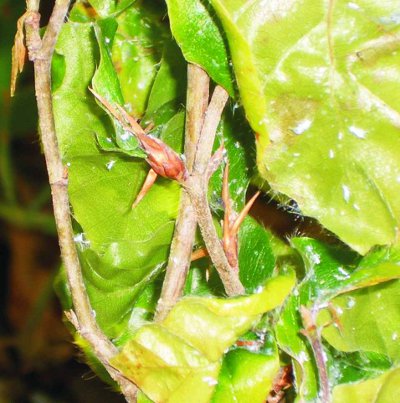 |
|
Figure 6 Uncontrolled aphids (whitefly) attacking newly planted beech trees. By kind permission of Dr Allan Clements. |
(a) Organophosphorus compounds
First introduced in 1944, organophosphorus compounds (OPs) are economically still the most successful and diverse chemical class of insecticide. More than 100 different active ingredients belonging to this class are known. One of the most successful OPs is considered to be chlorpyrifos. This non-systemic insecticide, used on both the foliage and the soil, affects the stomach and respiratory action of the pest.
All OPs act by binding irreversibly to the enzyme, acetylcholinesterase (AChE). This prevents the hydrolysis of the neurotransmitter acetylcholine in the central nervous system (CNS) and leads to prolonged periods of nerve excitation. This then results in paralysis and subsequently death of the insects and their predators. OPs are used to control almost all pests including Lepidoptera (e.g. moths), Coleoptera (e.g. beetles), Diptera (e.g. flies, such as whiteflies, and mosquitoes), Hemiptera (e.g. aphids and leafhoppers). Additionally they control nematodes (parasitic worms) and mites. Four examples are:
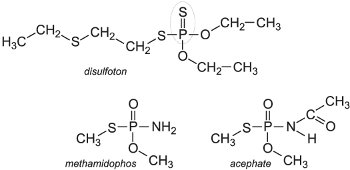

The major disadvantage of most OPs is their toxicity to vertebrates and this has resulted in the search for other compounds to replace them.
Organophosphorus compounds are rapidly broken down by enzymatic action in the soil.
(b) Methyl carbamates
Another important class of AChE inhibitors, introduced in the late 1950s, is the methyl carbamates which are usually less toxic to non-target organisms than the organophosphorus compounds.
Their structural features are found in a natural product isolated as early as 1864, physostigmin (eserin), the structure of which was finally elucidated in 1925.
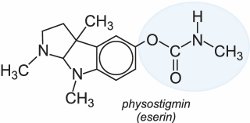
They have short to moderate effective life, but are more selective in their effect. Pirimicarb is one of the most important methyl carbamates for aphid control. It was launched as a foliar spray for vegetables, arable crops and fruits in the early 1970s and is harmless to pollinating insects and aphid predators. Other widely applied carbamates are aldicarb which is used primarily as a soil insecticide and bendiocarb which is very important for the control of malaria-transmitting adult mosquitoes.
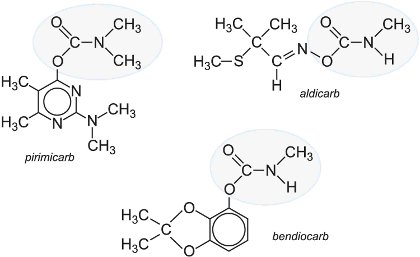
(c) Macrocyclic lactones (avermectins and milbemycins)
All natural and semi-synthetic 16-membered macrocyclic lactones disturb the systems which control the flow of chloride ions. This shuts down the electrical impulses in the nerve cells of their target organisms.
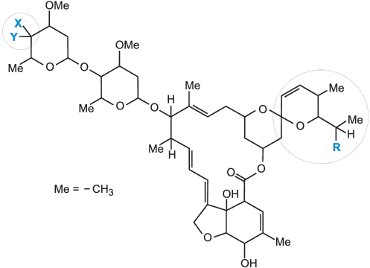
| X | Y | R | |
|---|---|---|---|
| avermectin B1 | OH | H |
>80% C2H5 <20% CH3 |
| emamectin benzoate | H | NH-CH3 |
>90% C2H5 <10% CH3 |
The naturally occurring avermectins and emamectin benzoate are based on the above structure. The avermectins are produced by fermentation from the soil microorganism Actinomycetes (from the genus Streptomyces) and emamectin benzoate is prepared from abamectin in a series of chemical reactions. Another naturally occurring example is milbemycin.
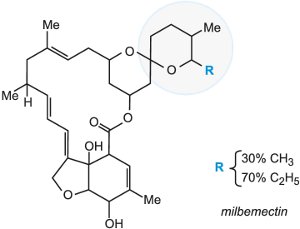
The whole family of macrocyclic lactones displays unprecedented potency against mites and insects as well as nematodes (e.g. parasitic worms). Avermectin is used in various crops such as citrus, pome fruits (for example, apples and pears), vegetables and cotton. Milbemectin is mainly used to combat the many different mites in tea and pome fruits (e.g.apples), and also against pine wood nematode which devastates pine trees in Japan and parts of the US.
The products are non-systemic and are removed rapidly from the environment after application. Photolysis on plant surfaces is fast, and they bind tightly to soil, where they are rapidly degraded by soil microorganisms. Thus, no leaching or bioaccumulation occurs. Because of the rapid uptake into sprayed foliage combined with fast degradation of surface residues, this family of insecticides is safe to use.

(d) Phenylpyrazoles
A well-known member of this class of insecticides is fipronil, which can be applied to the foliage, soil and seeds. However, it has a limited ability to translocate through the plant. Fipronil acts by disturbing the chloride ion concentrations in cells in pest species such as the Lepidoptera (moths), Coleoptera (beetles) and Diptera (flies, mosquitoes). For example, it is widely used as a foliar spray for the control of leaf- and planthoppers in rice in south-east Asia.
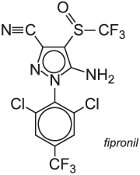
Other applications of the phenylpyrazoles include the control of urban pests such as ants and cockroaches indoors and on lawns. They are also very effective in controlling termites. In animal health care, they are used on cats and dogs to combat ticks and fleas.

(e) Nereistoxin analogues and neonicotinoids
Much work has been devoted to finding chemicals which will prevent the nicotinic acetylcholine receptor (nAChR) from functioning correctly. The receptor is important in allowing the passage of sodium and potassium ions in the nerve cells and thus affects the central nervous system. First examples of these insecticides are cartap, thiosultap, bensultap and thiocyclam.
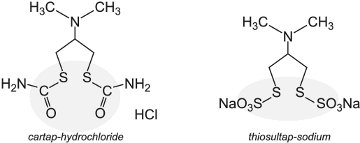
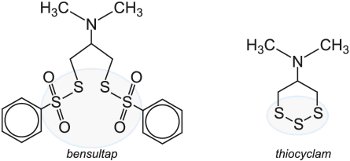
They break down either by action of water or light to produce the toxin, nereistoxin, a substance that was first isolated from the naturally occurring marine nereid worm Lumbrineris heteropoda Marenz, which acts by effectively paralyzing the pest.
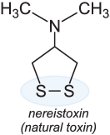
Another group of insecticides which affect the nicotinic acetylcholine receptor is the neonicotinoids which are now the fastest growing and fourth major class of insecticides in crop protection. They are active against a broad range of insect pests, and exhibit activity through both oral (ingestion) and contact routes of application. They have a high level of efficacy, and a favourable environmental and toxicological profile. This has led to their rapid adoption in numerous agricultural areas for quick control of a broad range of chewing and sucking pests with minimum impact on beneficial insects.
Like the naturally occurring alkaloid nicotine (used for a long time in the form of aqueous tobacco extract),
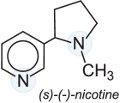
neonicotinoids act selectively on and overstimulate the insect's central nervous system. The following are examples of this class of pesticide:
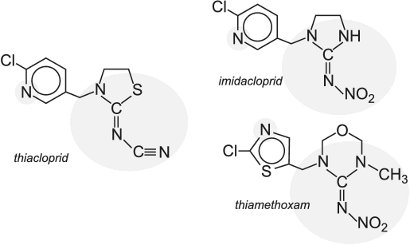
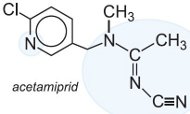 |
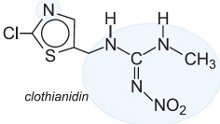 |
They have been shown to have long-lasting effect, both when treating the leaves and the seeds. Further, they have a relatively low risk for non-target organisms, although recently there have been concerns that they may be contributing to the significant decline in honey bee populations. The environment agencies in several countries are currently assessing the evidence for this.

(f) Diamides
Diamides represent a new class of insecticidal chemistry, which include the phthalic acid diamides and the anthranilic diamides (chlorantraniliprole). They act on the cell's ability to control the flow of calcium ions (ryanodine receptors).
Flubendiamide is an example of a phthalic acid diamide:
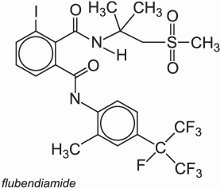
Chlorantraniprole is an example of an anthranilic diamide:
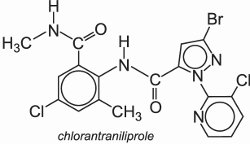
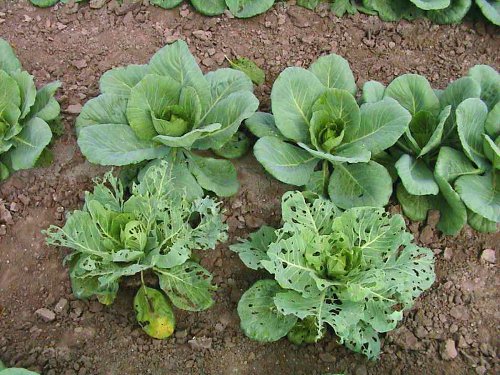 |
|
Figure 7 Rynaxypyr® is used to protect cabbages from the ravages of caterpillars. By kind permission of DuPont. |
It is marketed under several names, for example Rynaxypyr® (Figure 7).
The ryanodine receptor as an insecticide target site has been known for decades and is named after the natural plant-derived (alkaloid) insecticide, ryanodine. Although ryanodine's insecticidal properties are limited under field conditions, diamide insecticdes have been developed which are specific to insect ryanodine receptors and are particularly active against Lepidoptera (moths). Diamides protect fruit and vegetables from beetles, weevils, leaf miners and caterpillars.
They do not affect mammalian ryanodine receptors, most probably explaining their excellent toxicological profile, being specific to the pests and not affecting natural predators or pollinators and being non-toxic to mammals, fishes and birds.
(g) Pyrethroids
Among the most important chemical classes of insecticides is the pyrethroids, which affect the flow of sodium ions in the nervous system. In the middle of the 19th century an insecticidal powder derived from dried flower heads of the genus Pyrethrum (Chrysanthemum) was introduced from Africa to central Europe. The insecticidal components were identified as pyrethrins. As they have several asymmetric centres these compounds have many stereochemical forms, and only a few of them are active as an insecticide. Natural pyrethrins I and II are unstable, sensitive to photo-degradation and relatively expensive. However, these natural pyrethrins were used as templates to generate analogues, the so-called synthetic pyrethroids. They act on contact with the plant.
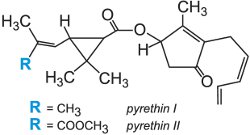
They can be separated into two classes according to the poisoning action they induce. Type I pyrethroids (e.g. permethrin) cause hyperactivity and incoordination, whereas Type II pyrethroids (e.g. deltamethrin) containing an alpha-cyano substituent induce nerve depolarization (polarization being needed to transmit the electrical signals in the nervous system) and subsequently paralysis of the insect. Pyrethroids are highly active against Lepidoptera pest species, but their speed of action, which leads to rapid knock-down, means they are used successfully in many crops against numerous pests including aphids.
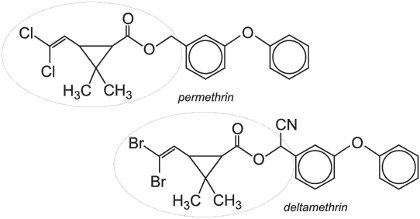
Pyrethroids are very useful insecticides as, although toxic to insects, they are harmless to mammals. They are non-systemic and are rapidly broken down in the soil. They are also used as indoor residual spray or on insecticide-treated nets for the control of malaria mosquitoes.
(h) Benzoylureas
Benzoylureas have been developed and used as commercial insect growth regulators (IGRs) acting by inhibiting the biosynthesis of chitin (a long chain polymer of N-acetylglucosamine which is in the cell walls of the insect). Diflubenzuron was one of the first of this class to be used commercially when it was introduced in 1977. It is used for the control of chewing insects and coleopteran pests (beetles and weevils) in fruit, cotton, soybeans and vegetable crops.
Because of their non-toxicity to vertebrates, the benzoylureas such as lufenuron and triflumuron are also used in veterinary medicine and in the home against animal and human health pests such as fleas, ticks and cockroaches.
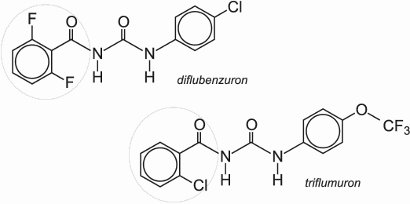
(i) Ketoenols
Ketoenols are a new chemical class of insecticides affecting development by inhibiting acetyl CoA carboxylase and subsequent lipid biosynthesis. Spirodiclofen is a new non-systemic foliar acaricide (kills mites and ticks). It has particularly excellent long lasting efficacy and is effective in early to late season applications for spider mite control. Spirodiclofen is being developed for worldwide use in pome fruit (e.g apples, pears), stone fruit, citrus fruit, grapes, almonds and nuts, being very effective against mites. Spiromesifen is a new foliar contact acaricide and has been used worldwide on vegetables, fruits, cotton, corn, beans, tea and some ornamentals.
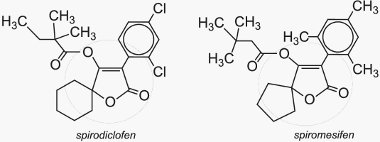


RELATED TAGS: WHAT IS INSECTICIDE,WHAT IS INSECTICIDE CHEMICALS,MAKING INSECTICIDE CHEMICALS,USES OF INSECTICIDE CHEMICALS,PRODUCTION OF INSECTICIDE CHEMICALS,RAW MATERIALS OF INSECTICIDE CHEMICALS,CHEMICALS OF INSECTICIDE.INSECTICIDE CHEMICALS PRODUCTION,TYPES OF INSECTICIDE CHEMICALS.
SOLVER CHEM

|
|

|
|

|
|
